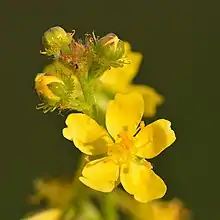Agrimonia
Agrimonia (from the Greek ἀργεμώνη),[1] commonly known as agrimony, is a genus of 12–15 species of perennial herbaceous flowering plants in the family Rosaceae,[1] native to the temperate regions of the Northern Hemisphere, with one species also in Africa. The species grow to between .5–2 m (1.6–6.6 ft) tall, with interrupted pinnate leaves, and tiny yellow flowers borne on a single (usually unbranched) spike.
| Agrimonia | |
|---|---|
 | |
| Agrimonia eupatoria | |
| Scientific classification | |
| Kingdom: | Plantae |
| Clade: | Tracheophytes |
| Clade: | Angiosperms |
| Clade: | Eudicots |
| Clade: | Rosids |
| Order: | Rosales |
| Family: | Rosaceae |
| Subfamily: | Rosoideae |
| Tribe: | Sanguisorbeae |
| Subtribe: | Agrimoniinae |
| Genus: | Agrimonia Tourn. ex L. |
| Species | |
|
About 15 species; see text | |
Agrimonia species are used as food plants by the larvae of some Lepidoptera species including grizzled skipper (recorded on A. eupatoria) and large grizzled skipper.
Species
- Agrimonia eupatoria – Common agrimony (Europe, Asia, Africa)
- Agrimonia gryposepala – Common agrimony, tall hairy agrimony (North America)
- Agrimonia incisa – Incised agrimony (North America)
- Agrimonia coreana – Korean agrimony (eastern Asia)
- Agrimonia microcarpa – Smallfruit agrimony (North America)
- Agrimonia nipponica – Japanese agrimony (eastern Asia)
- Agrimonia parviflora – Harvestlice agrimony (North America)
- Agrimonia pilosa – Hairy agrimony (eastern Europe, Asia)
- Agrimonia procera – Fragrant agrimony (Europe)
- Agrimonia pubescens – Soft or downy agrimony (North America)
- Agrimonia repens – Short agrimony (southwest Asia)
- Agrimonia rostellata – Beaked agrimony (North America)
- Agrimonia striata – Roadside agrimony (North America)
Uses
In the ancient times, it was used for foot baths and tired feet.[2] Agrimony has a long history of medicinal use. The English poet Michael Drayton once hailed it as an "all-heal" and through the ages it was considered a panacea. The ancient Greeks used agrimony to treat eye ailments, and it was made into brews for diarrhea and disorders of the gallbladder, liver, and kidneys. The Anglo-Saxons boiled agrimony in milk and used it to improve erectile performance.[3] They also made a solution from the leaves and seeds for healing wounds; this use continued through the Middle Ages and afterward, in a preparation called eau d'arquebusade, or "musket-shot water". It has been added to tea as a spring tonic.[2]
Folklore
Traditional British folklore states that if a sprig of Agrimonia eupatoria was placed under a person's head, they would sleep until it was removed.[4]
See also
- Aremonia agrimonioides (Bastard-agrimony, of the related genus Aremonia)
- Eupatorium cannabinum (Hemp-agrimony)
References
- Chisholm, Hugh, ed. (1911). . Encyclopædia Britannica. 1 (11th ed.). Cambridge University Press. p. 424.
- C. F. Leyel. Compassionate Herbs. Faber and Faber Limited.
- Lacey, R. and Danziger, D. (1999) In The Year 1000 London: Little, Brown & Co, p. 126
- Encyclopedia of Folk Medicine: Old World and New World Traditions by Gabrielle Hatfield, p.310
- Eriksson, Torsten; Hibbs, Malin S.; Yoder, Anne D.; Delwiche, Charles F.; Donoghue, Michael J. (2003). "The Phylogeny of Rosoideae (Rosaceae) Based on Sequences of the Internal Transcribed Spacers (ITS) of Nuclear Ribosomal DNA and the TRNL/F Region of Chloroplast DNA". International Journal of Plant Sciences. 164 (2): 197–211. doi:10.1086/346163. S2CID 22378156.
External links
![]() Media related to Agrimonia at Wikimedia Commons
Media related to Agrimonia at Wikimedia Commons
![]() Agrimonia at Wikibooks
Agrimonia at Wikibooks
- "Agrimonia L." Atlas of Living Australia.
